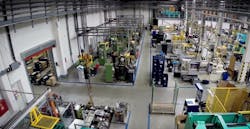Digital Performance Management: A New Tool for Closed-Loop Continuous Improvement
Though industrial automation professionals are not lacking in three-letter acronyms for the technologies they use, it’s time to make way for a new one—DPM, which stands for digital performance management.
According to Jeffrey Miller, director of industrial high tech at Kalypso (a Rockwell Automation company focused on digital enterprise technologies and services), DPM is a new closed-loop operating system for continuous improvement in manufacturing that’s been around for less than two years.
In a presentation at PTC’s LiveWorx 2023 event (Rockwell Automation is a PTC partner company), Miller explained: “DPM is a set of modularized tools that collect data from PLCs and other automation devices and systems and presents the data to operators, quality teams and continuous improvement engineering teams in new ways to make it easier to gain insights about time losses in production. It’s about exposing information you already have.”
Miller was quick to point out that, though PTC’s Thingworx DPM is a new tool for industry, it was built using proven manufacturing methods including W. Edwards Deming’s “plan, do, check, act” and Eliyahu Goldratt’s “drum, buffer, rope.”
“DPM is built on convergence of principles and technologies developed over the past 40 years,” he said. “Many core DPM processes, such as lean principles, closed-loop problem solving, Pareto analyses, takt time, pacesetter and bottlenecks, are functionally unchanged from their analog versions. In DPM, they’re simply conducted with the utility of real time, digital data acquired directly from operations. Nothing in DPM is revolutionary—but it is innovative.”
The first thing DPM identifies are production bottlenecks using takt time, Miler said. When automation devices feed data into a manufacturing execution system or similar technology, event codes are generated whenever production stops. To prepare this system data for use in DPM, “we categorize these events by planned or unplanned downtime, stoppages, scrap, changeovers, speed loss, etc.,” said Miller. “These categorizations are actionable because they identify the root cause of losses.”
He added that DPM’s ability to direct action items to improve operations is why continuous improvement teams often “become evangelists for DPM.” It justifies the OpEx budget by creating investment accountability to confirm which continuous improvement investments produce desired results.
OEE connections and differences
Observing that industrial companies tend to have a “strong over-reliance on OEE,” Miller explained that OEE can be an ineffective tool because it is often manipulated by users changing factors used in the OEE equation of availability x performance x quality = OEE. This ability to manipulate OEE also renders it ineffective for making comparisons between plants, he said.
Highlighting the key differences between OEE and DPM, Miller said, “the goal of OEE is to report a value for OEE that ranges from 0-100%. The goal of DPM is to return hours to production.” Principal differentiators between OEE and DPM cited by Miller included:
- OEE can be manipulated by adjusting denominators; DPM cannot be manipulated (because it draws verifiable data for calculation directly from connected plant floor devices).
- OEE is difficult to measure across factory networks; DPM is scalable across any size network.
- OEE is low resolution; DPM is high resolution with time loss rankings.
- OEE does not provide a direct path to monetization; DPM focuses on monetizing production hours.
Thermo Fisher Scientific
Among the first users of DPM is Thermo Fisher Scientific (a manufacturer of medical devices and bio-pharmaceuticals). The company decided to explore use of DPM when it had to decide whether to invest in a new line to keep up with demand.
What led them to DPM was a sense among key personnel that they had the capacity they needed, but they couldn’t find it due to an inability to adequately determine time losses during manufacturing of a batch.
Thus, the goals driving deployment of DPM at Thermo Fisher Scientific were to identify time loss events and their causes, contextualize their automation data, implement closed-loop problem solving and configure a scalable, extensible system.
Miller said Thermo Fisher Scientific allotted 90 days to do this. They succeeded in less than half that time.
Results from Thermo Fisher Scientific’s use of DPM include achieving 130% of initial OEE improvement in 50% of expected time and doubling their seven-day rolling OEE in five months, generating millions of dollars in sustained, additional revenue.
The video below from PTC Thingworx provides an executive summary of how DPM works.
About the Author
David Greenfield, editor in chief
Editor in Chief

Leaders relevant to this article:

